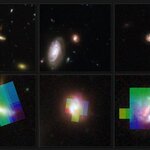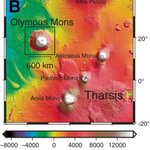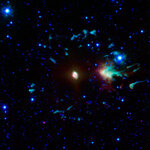Researchers have found evidence suggesting that stars rich in carbon complex molecules may form at the center of our Milky Way galaxy - and it helps solve a mystery. Namely, why have telescopes never detected carbon-rich stars at the center of our galaxy even though they have found these stars in other places?
This discovery is also significant because it adds to our knowledge of how stars form heavy elements like oxygen, carbon and iron and and then blow them out across the universe, making it possible for life to develop.
The team of scientists analyzed the light emitted from 40…
Space

A new map combining nearly three months of data from NASA's Fermi Gamma-ray Space Telescope is giving astronomers an unprecedented look at the high-energy cosmos. To Fermi's "eyes", the universe is ablaze with gamma rays from sources within the solar system to galaxies billions of light-years away.
A paper describing the 205 brightest sources the LAT sees has been submitted to The Astrophysical Journal Supplement. "This is the mission's first major science product, and it's a big step toward producing our first source catalog later this year," said David Thompson, a Fermi deputy project…

The Wii game 'Super Mario Galaxy' is a triumph of inventive game play and a favorite in our family. But oh, the muddled science message is like a bad version of the old "Who's on First" routine.
In the game, you collect star bits and bigger stars to open up planets that are called Galaxies. You can also feed stars, which turn into galaxies when they get fat. Each Galaxy is eminently walkable and about the size of a football field... or smaller. As a game player, it's great fun. As an astronomer, it's painful.
The issue comes to a crux when I have to correct my 7-year old's understanding…

Astronomers have obtained exceptional 3D views of distant galaxies, seen when the Universe was half its current age, by combining the the Hubble Space Telescope’s acute eye and the ESO’s Very Large Telescope to probe the motions of gas in tiny objects. By looking at this unique “history book” of our Universe, at an epoch when the Sun and the Earth did not yet exist, scientists hope to solve the puzzle of how galaxies formed in the remote past.
For decades, distant galaxies that emitted their light six billion years ago were no more than small specks of light on the sky. With the launch of the…

Is Pluto a planet? On Tuesday I talked about how 'Algol' isn't technically an Algol-type star system. This raised the interesting case of "is Pluto a planet". To a large degree, that's a non-argument. Pluto hasn't changed.
Here's an example I often run for students. All you readers out there, if you have dark hair-- black or brown hair-- raise your hands. Don't worry about your officemate starting, just raise those hands. Got them up?
Okay, I want everyone who has dark hair-- just black hair-- to raise your hands, but anyone else with their hand up, lower it. Yes, dark hair is now…

NASA's Cassini spacecraft has found within Saturn's G ring an embedded moonlet that appears as a faint, moving pinprick of light. Scientists now believe it is a main source of the G ring and its single ring arc.
Saturn's rings were named in the order they were discovered. Working outward they are: D, C, B, A, F, G and E. The G ring is one of the outer diffuse rings. Within the faint G ring there is a relatively bright and narrow, 250-kilometer-wide (150-miles) arc of ring material, which extends 150,000 kilometers (90,000 miles), or one-sixth of the way around the ring's circumference.…

The Martian volcano Olympus Mons is about three times the height of Mount Everest but it's the small details that Rice University professors Patrick McGovern and Julia Morgan are looking at in thinking about whether the Red Planet ever had life.
Using a computer modeling system to figure out how Olympus Mons came to be, McGovern and Morgan reached the surprising conclusion that pockets of ancient water may still be trapped under the mountain.
If there's still ancient water, there may still be ancient life, they say. Their research is published in Geology.
The scientists…

An Algol type star system is an eclipsing spectroscopic binary consisting of two close, interacting stars. Their X-ray emission is due to slow mass transfer due to Roche lobe overflow. Algol-type systems named after the first discovery of this type, the Algol system, researched by various astronomers from 1667 until Pickering and Vogel nailed what it was in 1889
However, later observations could have disqualified Algol from being an Algol-type system, since it's actually a triple star system (a trenary). However, saying that Algol is not an Algol-type system is just too silly. What's next…

A new Hubble image shows three galaxies locked in a gravitational tug-of-war that may result in the eventual demise of one of them.
About 100 million light-years away, in the constellation of Piscis Austrinus (the Southern Fish), three galaxies are playing a game of gravitational give-and-take that might ultimately lead to their merger into one enormous entity. A new image from the Advanced Camera for Surveys on the NASA/ESA Hubble Space Telescope allows astronomers to view the movement of gases from galaxy to galaxy, revealing the intricate interplay among them.
Panning on NGC 7173,…

Astronomers using a telescope aboard the NASA Swift Satellite have captured information from the early stages of a gamma ray burst - the most violent and luminous explosions occurring in the Universe since the Big Bang.
Swift is able to both locate and point at gamma ray bursts (GRBs) far quicker than any other telescope, so by using its Ultraviolet/Optical Telescope (UVOT) the astronomers were able to obtain an ultraviolet spectrum of a GRB just 251 seconds after its onset - the earliest ever captured. Further use of the instrument in this way will allow them to calculate the distance and…
